
Jamaica is an island country situated in the Caribbean Sea. Spanning 10,990 square kilometres (4,240 sq mi) in area, it is the third-largest island of the Greater Antilles and the Caribbean. Jamaica lies about 145 kilometres (90 mi) south of Cuba, and 191 kilometres (119 mi) west of Hispaniola ; the British Overseas Territory of the Cayman Islands lies some 215 kilometres (134 mi) to the north-west.

Kingston is the capital and largest city of Jamaica, located on the southeastern coast of the island. It faces a natural harbour protected by the Palisadoes, a long sand spit which connects the town of Port Royal and the Norman Manley International Airport to the rest of the island. In the Americas, Kingston is the largest predominantly English-speaking city south of the United States.

The Arctiinae are a large and diverse subfamily of moths, with around 11,000 species found all over the world, including 6,000 neotropical species. This group includes the groups commonly known as tiger moths, which usually have bright colours, footmen, which are usually much drabber, lichen moths, and wasp moths. Many species have "hairy" caterpillars that are popularly known as woolly bears or woolly worms. The scientific name of this subfamily refers to this hairiness. Some species within the Arctiinae have the word “tussock” in their common name due to people misidentifying them as members of the Lymantriinae based on the characteristics of the larvae.

The erebid moth Ascalapha odorata, commonly known as the black witch moth, is a large bat-shaped, dark-colored nocturnal moth, ranging from Brazil to the southern United States. It is the largest noctuid in the continental United States. In the folklore of many Central American cultures, it is associated with death or misfortune.

The Dalceridae are a small family of zygaenoid moths with some 80 known species encompassing about one dozen genera mostly found in the Neotropical region with a few reaching the far south of the Nearctic region.
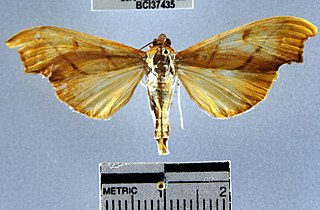
Sparagmia is a monotypic moth genus of the family Crambidae described by Achille Guenée in 1854. Its only species, Sparagmia gonoptera, described by Pierre André Latreille in 1828, is found in Central and South America and in the Antilles. Records include Argentina, Brazil, Panama, Costa Rica, Puerto Rico, Cuba and Jamaica.
Antiblemma rufinans, the live oak antiblemma, is a moth of the family Noctuidae. It is found in dry, sandy woodlands, barrens, and scrub forests of the southern Florida Plain. It is also present in South America, Cuba and Jamaica.

Fissicrambus profanellus is a moth of the family Crambidae. It is found in the southern part of the United States, the Caribbean and Central America.
Terastia meticulosalis, the erythrina twigborer or erythrina borer, is a moth of the family Crambidae. It has a wide distribution. In North America, it has been recorded from south-eastern Arizona, southern Texas, Louisiana and Florida. It is also present in Jamaica.
William Schaus was an American entomologist who became known for his major contribution to the knowledge and description of new species of the Neotropical Lepidoptera.
Jocara majuscula is a species of snout moth in the genus Jocara. It was described by Gottlieb August Wilhelm Herrich-Schäffer in 1871, and it is found in California, Florida, Central America, Cuba, Puerto Rico and Jamaica.
Gonodontodes dispar is a moth of the family Noctuidae. It is found on Cuba. An adult male of this species was collected in Key Largo, Florida, in 2009.
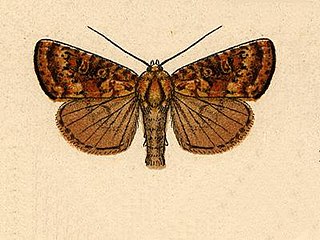
Perigea xanthioides is a moth of the family Noctuidae. It is found from Canada to Brazil and on Jamaica.
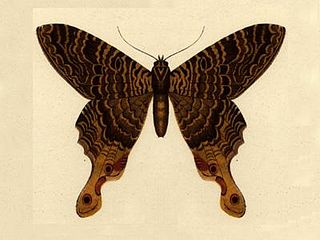
Mania aegisthus is a moth of the family Sematuridae. It is found in Jamaica, Haiti and Surinam.

Ptichodis herbarum, the common ptichodis moth, is a moth in the family Erebidae. It is found in the United States. It has also been recorded from Jamaica.
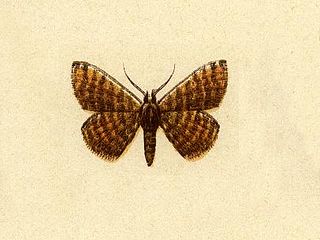
Leptostales phorcaria is a moth of the family Geometridae. It is found on Puerto Rico, Hispaniola, Jamaica, the Bahamas and St. Vincent.
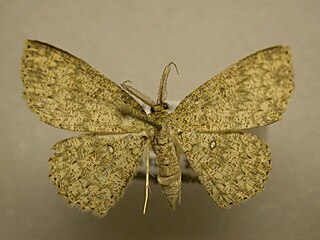
Cyclophora urcearia is a moth of the family Geometridae. It is found from Mexico to Paraguay and on Jamaica and in Trinidad.
Psychonoctua personalis is a moth in the family Cossidae. It was described by Augustus Radcliffe Grote in 1865. It is found on Cuba, Jamaica, Hispaniola and Puerto Rico.
Glaphyria bilinealis is a moth in the family Crambidae. It is found in Cuba, Jamaica, Puerto Rico and on the Virgin Islands.
Chionosticta niveisparsa is a species of beetle in the family Cerambycidae, and the only species in the genus Chionosticta. It was described by Holzschuh in 1981.












